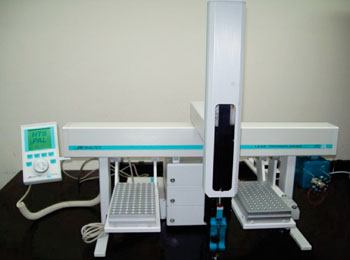Newly Discovered Marker Detects Early Pancreatic Cancer
|
By LabMedica International staff writers Posted on 16 Oct 2014 |

Image: The HTS PAL autosampler (Photo courtesy of Leap Technologies).
A marker in the blood that may indicate early development of the pancreatic ductal adenocarcinoma (PDAC) could pave the way for an early detection test.
Pancreatic cancer is difficult to diagnose early as the tumors cannot be felt like they can in some other cancers because the pancreas is so deep inside the body and the disease usually does not cause any symptoms until it has already spread to other organs.
Scientists at the Dana-Farber Cancer Institute (Boston, MA, USA) assessed previously collected blood samples from 1,500 people who were part of large health-monitoring studies. They looked for more than 100 compounds made during the metabolic process, known as metabolites, before dividing the samples into two groups: those that were from participants who later developed pancreatic cancer and those that were from participants who did not develop the disease.
Profiles of endogenous polar metabolites were obtained using liquid chromatography-tandem mass spectrometry (LC-MS) which consisted of a 4000 QTRAP triple quadrupole mass spectrometer (AB SCIEX; Framingham, USA) coupled to an 1100 Series pump (Agilent Technologies; Santa Clara, CA, USA) and an HTS PAL autosampler (CTC; Zwingen, Switzerland).
The team found that the participants who went on to develop pancreatic cancer had higher blood levels of branched-chain amino acids (BCAAs), which are essential nutrients that the body extracts from proteins found in foods, compared with participants who did not develop pancreatic cancer. The elevated plasma levels of BCAAs were associated with a greater than two-fold increased risk of future pancreatic cancer diagnosis. This elevated risk was independent of known predisposing factors, with the strongest association observed among subjects with samples collected two to five years before diagnosis, when occult disease is probably present.
The authors concluded that these increased BCAA levels were found in patients 2 to 25 years before they were diagnosed with pancreatic cancer, but they note that patients with high levels of these amino acids several years prior to diagnosis were at the highest risk. Matthew G.Vander Heiden, MD, PhD, co-senior author of the study said, “This work has the potential to spur progress in detecting pancreatic tumors earlier and identifying new treatment strategies for those with the disease.” The study was published on September 28, 2014, in the journal Nature Medicine.
Related Links:
Dana-Farber Cancer Institute
AB SCIEX
Agilent Technologies
Pancreatic cancer is difficult to diagnose early as the tumors cannot be felt like they can in some other cancers because the pancreas is so deep inside the body and the disease usually does not cause any symptoms until it has already spread to other organs.
Scientists at the Dana-Farber Cancer Institute (Boston, MA, USA) assessed previously collected blood samples from 1,500 people who were part of large health-monitoring studies. They looked for more than 100 compounds made during the metabolic process, known as metabolites, before dividing the samples into two groups: those that were from participants who later developed pancreatic cancer and those that were from participants who did not develop the disease.
Profiles of endogenous polar metabolites were obtained using liquid chromatography-tandem mass spectrometry (LC-MS) which consisted of a 4000 QTRAP triple quadrupole mass spectrometer (AB SCIEX; Framingham, USA) coupled to an 1100 Series pump (Agilent Technologies; Santa Clara, CA, USA) and an HTS PAL autosampler (CTC; Zwingen, Switzerland).
The team found that the participants who went on to develop pancreatic cancer had higher blood levels of branched-chain amino acids (BCAAs), which are essential nutrients that the body extracts from proteins found in foods, compared with participants who did not develop pancreatic cancer. The elevated plasma levels of BCAAs were associated with a greater than two-fold increased risk of future pancreatic cancer diagnosis. This elevated risk was independent of known predisposing factors, with the strongest association observed among subjects with samples collected two to five years before diagnosis, when occult disease is probably present.
The authors concluded that these increased BCAA levels were found in patients 2 to 25 years before they were diagnosed with pancreatic cancer, but they note that patients with high levels of these amino acids several years prior to diagnosis were at the highest risk. Matthew G.Vander Heiden, MD, PhD, co-senior author of the study said, “This work has the potential to spur progress in detecting pancreatic tumors earlier and identifying new treatment strategies for those with the disease.” The study was published on September 28, 2014, in the journal Nature Medicine.
Related Links:
Dana-Farber Cancer Institute
AB SCIEX
Agilent Technologies
Latest Pathology News
- New Imaging Method Opens Door to Precision Diagnostics for Head and Neck Cancers
- Faster Measurement of Vibrational Fingerprint of Molecules to Advance Biomedical Diagnostics
- Clinical Antibody Test to Quickly Detect Even Low Levels of Common Parasitic Infection
- Pioneering Microscopy Technique Improves Diagnosis of Glioblastoma Brain Tumors
- AI-Based Breast Cancer Test Uses Routine Digital Histopathology Images for Risk Stratification
- AI Model Identifies Sex-Specific Risks Associated with Brain Tumors
- Breakthrough Virus Detection Technology Combines Confocal Fluorescence Microscopy with Microfluidic Laminar Flow
- AI Technology Accurately Predicts Breast Cancer Risk Via ‘Zombie Cells’
- Liquid Biopsy Solution Enables Non-Invasive Sample Collection and Direct Cell-Free DNA Stabilization from Urine
- Innovative AI Tool Uses Digitized Whole-Slide Images for Intermediate-Risk Prostate Cancer Management
- AI-Based Tissue Staining Detects Amyloid Deposits Without Chemical Stains or Polarization Microscopy
- Super-Resolution Imaging Detects Parkinson's 20 Years Before First Motor Symptoms Appear
- New Technology for Sampling Body Liquids in Confined Spaces to Enable Early Cancer Detection
- New Technology Holistically Images Deep Living Tissue for The First Time
- New Molecular Sensor Enables Fluorescence Imaging for Assessing Sarcoma Severity
- New Biology Lab Tools Speed Up Tumor Dissection
Channels
Clinical Chemistry
view channel.jpg)
POC Saliva Testing Device Predicts Heart Failure in 15 Minutes
Heart failure is a serious condition where the heart muscle is unable to pump sufficient oxygen-rich blood throughout the body. It ranks as a major cause of death globally and is particularly fatal for... Read more
Screening Tool Detects Multiple Health Conditions from Single Blood Drop
Infrared spectroscopy, a method using infrared light to study the molecular composition of substances, has been a foundational tool in chemistry for decades, functioning similarly to a molecular fingerprinting... Read more
Integrated Chemistry and Immunoassay Analyzer with Extensive Assay Menu Offers Flexibility, Scalability and Data Commutability
As global healthcare systems increasingly shift towards networked laboratory operational models to enhance efficiency and patient access, there is a greater need for innovative solutions tailored to the... Read moreMolecular Diagnostics
view channel
Respiratory Panel to Help Clinicians Make Precise Treatment Decisions in Outpatient Settings
Respiratory tract infections are the primary reason for visits to emergency departments and subsequent hospitalizations. In the U.S., it is estimated that there are up to 41 million cases of influenza... Read more
Integrating Cardiovascular Risk Biomarkers Aids in Detection of ‘Inflammaging’
Cardiovascular diseases (CVD) continue to be the leading cause of death globally, responsible for nearly one-third of all fatalities worldwide. Traditionally, risk assessment for CVD has focused on well-established... Read more
Genetic Signature in Newborns Predicts Neonatal Sepsis Before Symptoms Appear
Neonatal sepsis, which occurs due to the body’s abnormal response to severe infection within the first 28 days of life, results in approximately 200,000 deaths globally each year. This condition affects around 1.... Read more.jpeg)
Integrating Multiple Protein Markers Predicts Health Outcomes in Chronic Kidney Disease Patients
Previous attempts to discover novel kidney biomarkers as risk factors for chronic kidney disease (CKD) progression have generally focused on evaluating proteins individually, which limits their prognostic... Read moreHematology
view channel
Next Gen CBC and Sepsis Diagnostic System Targets Faster, Earlier, Easier Results
Every hour is critical in protecting patients from infections, yet there are currently limited tools to assist in early diagnosis before patients reach a hospital. The complete blood count (CBC) is a common... Read more
Newly Discovered Blood Group System to Help Identify and Treat Rare Patients
The AnWj blood group antigen, a surface marker discovered in 1972, has remained a mystery regarding its genetic origin—until now. The most common cause of being AnWj-negative is linked to hematological... Read more
Blood Platelet Score Detects Previously Unmeasured Risk of Heart Attack and Stroke
Platelets, which are cell fragments circulating in the blood, play a critical role in clot formation to stop bleeding. However, in some individuals, platelets can become "hyperreactive," leading to excessive... Read moreImmunology
view channel
Computational Tool Predicts Immunotherapy Outcomes for Metastatic Breast Cancer Patients
Immunotherapy aims to enhance the body’s immune response to target cancer cells, but not all patients experience a positive reaction to such treatments. Identifying which patients will benefit from immunotherapy... Read more
Biomarker Could Predict Immunotherapy Response in Liver Cancer
Until recently, patients diagnosed with hepatocellular carcinoma had limited treatment options, with existing therapies extending life by only a few months. Immunotherapy has emerged as a new alternative... Read more
Epigenetic Test Could Determine Efficacy of New Immunotherapy Treatments Against Multiple Myeloma
Multiple myeloma is a blood cancer that primarily affects individuals over the age of sixty, and its occurrence rises as the population ages. In this disease, the bone marrow—the spongy tissue inside bones... Read moreMicrobiology
view channel
High-Accuracy Bedside Test to Diagnose Periprosthetic Joint Infection in Five Minutes
Periprosthetic joint infection (PJI) represents a significant global issue that is worsening as the number of joint replacements increases due to aging populations. In the United States alone, the anticipated... Read more_1.jpg)
Innovative Diagnostic Approach for Bacterial Infections to Enable Faster and Effective Treatment
For patients with bacterial infections, timely treatment with the appropriate antibiotics significantly improves their chances of recovery. Current methods for identifying which antibiotics will be effective... Read more
Non-Invasive Stool Test to Diagnose Endometriosis and Help Reduce Disease Progression
Endometriosis, a painful condition impacting nearly 200 million women globally, occurs when tissue similar to the lining of the uterus grows outside its usual location, such as on the intestines or the... Read more
Automated Positive Blood Culture Sample Preparation Platform Designed to Fight Against Sepsis and AMR
Delayed administration of antibiotics to patients with bloodstream infections significantly increases the risk of morbidity and mortality. For optimal therapeutic outcomes, it is crucial to rapidly identify... Read moreTechnology
view channel
New Noninvasive Methods Detect Lead Exposure Faster, Easier and More Accurately at POC
Exposure to lead can negatively affect health in multiple ways, leading to damage in the brain and central nervous system, delays in development and growth, learning and behavioral issues, problems with... Read more
Noninvasive Test Detects Malaria Without Blood Sample
Malaria remains a significant global health issue, with approximately 250 million cases and over 600,000 deaths reported annually. Nearly half of the world's population is at risk for malaria infection,... Read moreIndustry
view channel
Beckman Coulter Partners with BioPorto for Global Distribution of Acute Kidney Injury NGAL Tests
Acute kidney injury (AKI) is a sudden episode of kidney failure or damage that can occur within a few hours or days. This condition leads to the accumulation of waste products in the blood and disrupts... Read more_1.jpg)
CACLP 2025 New Date and Venue Announced
The 22nd China International In Vitro Diagnostic Expo, organized by the China Association of Clinical Laboratory Practice Expo (CACLP, Shanghai, China), is set to take place from March 21 to 24, 2025,... Read more
Roche to Develop New Diagnostic Technologies for Traumatic Brain Injuries
Traumatic brain injuries (TBI) represent a significant global health issue, affecting approximately 69 million people each year. TBI occurs when an external force disrupts normal brain function, with severity... Read more















